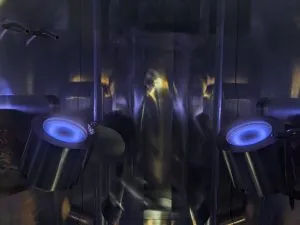What Is RF Sputtering? The Process and Applications Explained
Sputtering — from the Latin sputare, meaning “to spit out noisily” — is a coating process in which the target surface receives a thin film of sputtered or accelerated metal ions.
The process starts with placing the target coating material and the target surface, also known as the substrate, in a vacuum chamber. Inert gas, such as argon, neon, or krypton, is then directed into the chamber. Next, a power source sends an energetic wave through the gas to ionise the gas atoms, liberating electrons from the atoms and giving them a positive charge and creating what is known as a plasma.
The negatively charged target material attracts the positive ions. A collision ensues, in which the positive ions displace the target atoms and break them up into a spray of particles that “sputter off”, crossing the vacuum chamber and landing on the substrate as a thin film coating. The exact sputtering rate depends on multiple factors, including the current, the plasma’s energy, and the target material’s physical properties.
Radio frequency (RF) sputtering is a sputtering method that uses a high-voltage alternating current (AC) power source to supply power to the magnetron and create positively charged sputtering gas. The more traditional method of direct current (DC) sputtering uses DC power to achieve this giving the plasma slightly different properties.
Both RF and DC sputtering create a local plasma around the target meaning that only material on the target is sputtered in order to protect the chamber and substrate and create fast deposition rates.
A Closer Look at the RF Sputtering Process

Like traditional DC sputtering, the RF sputtering process begins by placing the target material, the substrate and the RF electrodes in a vacuum environment. The power source is then switched on, a magnetic field is created around the deposition source and the process gas atoms are ionised. The ionised gas ions hit the target material, breaking the sputtered atoms up into a fine mist that covers the substrate.
The main way that RF and DC sputtering differ is in their voltages. Direct current systems require 2,000-5,000 volts, in contrast, RF sputtering requires 1,012 volts or higher to deliver the same deposition rate. This is mainly because DC sputtering involves direct ion bombardment of the gas plasma by electrons, while RF sputtering uses kinetic energy to remove the electrons from the outer shells of the gas atoms.
Another difference between DC and RF sputtering is that RF sputtering can maintain the gas plasma at a significantly lower chamber pressure of under 1.5e-3 Torr, compared to the 1e-2 Torr required for DC sputtering. This helps reduce the number of collisions between the charged plasma particles and the target material, creating a more direct pathway to the sputter target.
Using RF power also helps prevent a common side effect of DC sputtering — the charge build-up on the target material due to the large number of energetic ions in the chamber, this allows for sputtering to be achieved on non-conducting materials.
Exploring the Various Applications of RF Sputtering
Common industrial applications of sputtering processes include:
- Consumer electronics: CDs, DVDs, LED displays, hard and floppy magnetic disks
- Optics: Optical filters, precision optics, laser lenses, spectroscopy, cable communications, anti-reflective and anti-glare coatings
- Energy: Solar panels, gas turbine blade coatings
- Lasers: Fibre lasers and semiconductor lasers
- Medicine and science: Medical devices, implants, microscopy, microanalysis sample slides
- Decorative: Architectural glass, packaging, toys, jewellery, clothing, building hardware, appliance trim, plumbing fixtures
Glass is one of the most common sputtering targets for thin film deposition.
RF sputtering, in particular, is ideally suited for sputtering target materials with insulating qualities due to the combination of lower chamber pressure and the use of radio frequency rather than a DC power supply. Alternative methods, such as DC sputtering, are limited when it comes to dielectric or non-conducting coatings that can take on a polarised charge.
This has made RF sputtering the go-to technique to deposit thin films of highly insulating oxides, such as aluminium oxide, tantalum oxide, and silicon oxide, onto metallic target surfaces between layers of microchip circuitry in the computer and semiconductor industries.
However, unless there is a trapping of secondary electrons above the target as with conventional magnetron sputtering, RF sputtering has a slower deposition rate than DC sputtering. The lack of a magnetic field and the higher RF power costs mean that RF sputtering is best suited for smaller target surfaces.
Innovations and Advancements in RF Sputtering Technology
Thin film deposition through sputtering has brought innovation and superior performance to various sputtering targets in a wide array of industries. The versatility of RF sputtering, in particular, makes it possible to tailor the properties of thin solid films in ways not always available with other methods, such as thermal evaporation.
Sputtering deposition is compatible with a broader range of target materials, including diverse mixtures and alloys. Its higher energy transfer makes for more uniform films, better surface adhesion of target atoms, and higher electron densities, even at low temperatures.
Conclusion: The Importance and Impact of RF Sputtering in Modern Industry
When RF and DC sputtering technologies first arrived on the scene in the 1970s, thin film deposition through ion bombardment and sputtering gas atoms — and especially RF magnetron sputtering — were considered useful mainly in electronics and semiconductor devices.
Since then, however, RF sputtering has greatly expanded its range of applications and is now a commonly used method in fields as diverse as energy, optoelectronics, life sciences, mechanics, the chemical industry, optical coatings, and many more.
In the coming years, experts predict the global RF sputtered films market will continue growing at a robust rate due to the demand for miniaturisation of thin-film devices, products, and technologies necessary for next-generation nano-technological applications.
References
[1] P. D. Davidse and L. I. Maissel (1966). Dielectric Thin Films through rf Sputtering. Journal of Applied Physics, 37, 574. DOI: 10.1063/1.1708218.
[2] F. M. D’Heurle (1970). Aluminum films deposited by rf sputtering. Metallurgical and Materials Transactions B, 1, 725-732. DOI: 10.1007/BF02811600.
[3] J. Sheng, J. Lee, W. Choi, T. Hong, M. Kim, and J. Park (2018). Review Article: Atomic layer deposition for oxide semiconductor thin film transistors: Advances in research and development featured. Journal of Vacuum Science & Technology A, 36:6. DOI: 10.1116/1.5047237.
[4] H. Biederman (2000). RF sputtering of polymers and its potential application. Vacuum, 59: 2–3, 594-599. DOI: 10.1016/S0042-207X(00)00321-3.
[5] J. H. Keller and W. B. Pennebaker (1979). Electrical Properties of RF Sputtering Systems. IBM Journal of Research and Development, 23:1. DOI: 10.1147/rd.231.0003.
